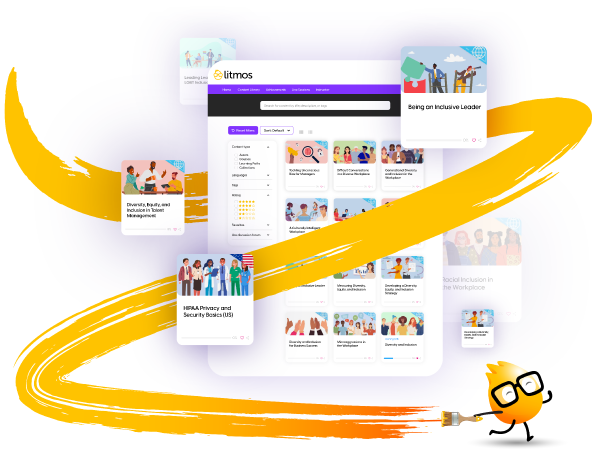Using All the Features: Beating the 80/20 Rule with Customer Training
It’s an oft-quoted saying in IT: 80 percent of customers only use 20 percent of the features in the software they’ve bought.
This may sound like an exaggeration, but let’s do an experiment: how many of your phone’s features and pre-installed apps do you actually use? How many more would you be using if the company that sold you your phone onboarded you with customer training? How much more efficient would your use of your phone be?
Now imagine that every time your phone updated, you’d get a learning module to walk you through new features. Even better, imagine if a high-energy trainer walked you through the new features in customer-focused release in a webinar. Bet you’d be much more likely to explore new capabilities. I’m also willing to bet you’d be a happier customer (kind of like the Litmos customers who flock to Litmos University to learn as much as possible about their LMS).
What is the 80:20 rule?
The 80:20 rule is a version of the 122-year-old Pareto Principle, which states that 80 percent of the effects come from 20 percent of the causes. The Pareto Principle has been applied to everything from economics to sports, but this particular version was outlined in 2002 by Jim Johnson, chairman of the Standish Group.
According to Standish’s research and more recent estimates, 20 percent of software features are often used, while 50 percent of features are hardly ever or never used. The remaining 30 percent of features are used infrequently. (For package applications, like Microsoft Office, Standish found that just five percent of features are used.) A more recent report form Pendo in 2019 reinforced these findings, confirming that 80 percent of features in the average software product are rarely or never used.
All of this means that if you develop and sell technology, most of your customers aren’t using all of the features in the software they’ve purchased from you.
This may not seem like a problem — so what if customers are only using a fraction of the features they paid for?
There are several reasons you want your customers to be engaged with — or at least aware of — all your software’s features. You want them to understand your product, to use it correctly, and to not become so frustrated that they’re calling customer support for information they should be getting from a tutorial.
This is where external training comes in. Targeting your product training to meet the needs of learners outside of your business, but in your business ecosystem (such as customers, partners, and vendors) can ultimately improve adoption and retention.
Anticipating customer service needs
Most customers do not want to get in touch with customer service. Also, your customer service reps, help desk, and salespeople have enough to do without having to answer the most basic questions about your product. By onboarding your customers as you would an employee, you’re getting out in front of the most common frustrations and questions to customer service.
This is a good thing for both you and your customer: your customer service representatives don’t have to spend time and money answering repetitive inquiries and your customers will be spared the frustration of having to to contact you for a simple inquiry.
Selling your customers on every feature
Your customer has bought your product, but are they sold on everything your offer?
Let’s go back to the smartphone example. How many of your current phone’s features have you stumbled upon by accident? How many apps have you downloaded that duplicate the function of one of those features?
You definitely don’t want existing customers to seek out features you offer from other companies simply because they’re unaware of them.
Even if your customer bought your applications because they wanted very specific features, but a solid onboarding course that gives them an overview of the entire product will make them aware of all the features available and give them a good idea of the ones they’d like to use.
This is a win for your customer, because even if they don’t choose to use every feature, they understand what the features are. It’s a win for you because your customers aren’t paying another company for features you already provide.
Using learning to engage customers
Your training is a conversation between you and the end user.
That’s a channel of communication you don’t get through marketing or customer service. You’re in the role of teacher. You get to show your customer what’s so great about your product once they’ve already made a purchase, and you get to share your enthusiasm and expertise with them.
It’s also an ongoing conversation. Every time you launch a new feature or update, you can release training that will help you walk your users through so they know what they’re getting.
Even more importantly tracking the right customer training metrics, and asking for regular feedback enables you to find out what your customers want to learn about your product. That feedback will help you understand your customers’ goals.
Training increases customer loyalty
It’s important to understand that a successful customer training program isn’t really about your goals as a company – it’s about the customer’s goals.
Author Kaliym Islam, wrote in Training Industry that there is a link between customer education and loyalty. In a research study, he found that customer loyalty increased when customers:
- perceived education programs as offering useful information
- perceived that the presentation of education programs was professional
- perceived that education programs offered information in a way that was manageable
In other words, customers appreciated a well-made, manageable training program that offered information that’s useful to them.
Improving customer training
Len Markidan, head of marketing at Groove, once wrote that there were two important milestones in the life cycle of a customer: first, when they sign up for your product or service, and second, when they achieve their “first success” with your product.
Your customers have already hit that first milestone by buying your product. Training allows you to help them achieve the second. By taking decisive actions to make your customer training more relevant and engaging, you can more easily guide customers beyond the initial onboarding phase, and help them use your product more effectively and confidently. Customer training not only ensures that customers beat the 80:20 rule, but illustrates your company’s commitment to customer success.
Ready to take the next steps toward increasing customer adoption and retention? The Litmos Customer Training Playbook aims to help you harness the power of training to drive customer adoption, retention, and growth. Our play-by-play customer education guide includes insights and strategies for making customer training frictionless, data-driven, and high-impact. Download your free Customer Training Playbook today!




